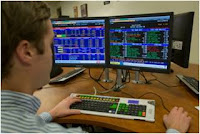AIM Students Received Valuable Investment
and Risk
Management Lessons in 2016
All of the students in the AIM program have
received valuable experience in evaluating and managing real investment
portfolios. Each year there seems to be new risks that the students have to
content with when managing the funds – and 2016 was no different than prior
years.
The CME Group recently published an article on:
Seven of the Most Noteworthy Trading
Days of 2016 (http://www.cmegroup.com/education/featured-reports/the-seven-most-noteworthy-trading-days-of-2016.html).
This article highlighted several of the most interesting trading days in 2016 –
it generated many useful lessons for investors and risk managers. Here are examples:
1.
Political risk was probably the top market
driver in 2016. As evidenced by the U.S. elections, UK Brexit referendum, and
other elections across the globe political events drove equity and fixed income
markets (as shown in the two charts below). As the CME Group points out, elections often
involve binary choices, which in turn mean that pre-event return expectations
may display bimodal characteristics. For instance, if event A occurs then
valuations are rates should go up; however if event B happens then prices and/or
rates will go down. In any case there is a small likelihood that the markets will
be flat once the outcome becomes known.
 |
| Pre- and Post-Election US Financial Markets(click to enlarge) |
 |
| Impact of UK Brexit Vote |
2.
Policy risk was also in focus during
much of 2016. In the U.S., the anticipated actions of the Federal Reserve
and post-election fiscal policy has moved markets significantly in the fourth
quarter of the year. In contrast, the other major central banks (ECB and
BOJ) remain committed to aggressive easing. These sharpening policy
divergences moved markets in 2016 and will continue to be major drivers in
2017, including foreign exchange, commodities, interest rates, and equities
markets.
 |
| Federal Reserve Rate Increase in December 2016 |
3.
Event risk was also evident in 2016 with
OPEC’s unexpected announcement in the fourth quarter to limit oil production. The
tensions in the energy markets were highlighted all through 2016 and oil prices
were extremely volatile. As the CME Group pointed out, Saudi Arabia
attempted to reassert itself as the world’s swing producer – willing to cut
production to support prices. While U.S. shale producers have grown ever
more efficient and can ramp up rig count and production when prices rise.
Expect 2017 to contain numerous surprises that will impact commodity and
financial markets.
 |
| Crude Oil Movement in 2016 |
4.
Secular, technology and weather/environmental
risks
continue to move markets. Changing demographics, disruptive technologies,
emphasis on ESG, and changing global weather patterns are likely to emerge as
major influences on financial and agricultural markets in 2017. The CME
Group article mentioned that the El Niño weather pattern of August 2015 left
the scene in 2016, and signs of a developing La Niña with colder-than-usual
waters along the equator in the Pacific Ocean, as well as large swaths of
colder waters in the Northern Pacific Ocean, are expected to shift jet stream,
temperature, and precipitation patterns yet again.
These are just some examples of the lessons learned by the AIM
students in 2016 as they manage a global portfolio of equities and fixed income
securities. Dr. David Krause, AIM program director has said that one of the
most valuable aspects of the Applied Investment Management program is the experience
gained by the students in evaluating investments and managing an active global portfolio.
The students are appreciative of the opportunity to manage some of the
University’s endowment – and they do so in a professional and responsible
manner.
Let’s see how the AIM students fare in 2017! Happy New Year…..










